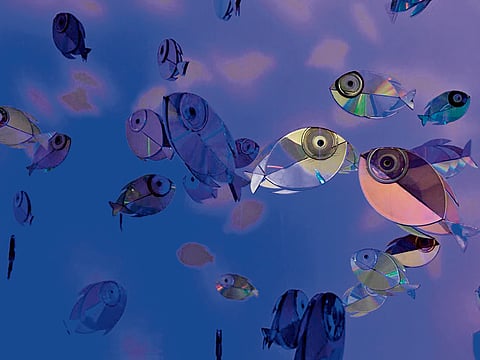
- LIFESTYLE
- FASHION
- FOOD
- ENTERTAINMENT
- EVENTS
- CULTURE
- VIDEOS
- WEB STORIES
- GALLERIES
- GADGETS
- CAR & BIKE
- SOCIETY
- TRAVEL
- NORTH EAST
- INDULGE CONNECT

In a world inundated with plastic, where it invades our oceans, our bodies, and even the air we breathe, hope seems to be a distant dream. Yet, for OK Jeong Lee and her team, hope isn’t just a fantasy. It is a reality that we create, piece by piece, in ways that transform what is discarded into something profound, beautiful, and alive. Her exhibition Blue Planet isn’t just a showcase; it’s a call to action—a visual plea to confront the mounting environmental crisis, wrapped in the shimmering embrace of upcycled art. Through this exhibition, Jeong encourages us to look beyond the waste that surrounds us and see the beauty and possibility that lie within it.
“Our world is drowning in plastic—breaking down into microscopic pieces, entering our bodies, our oceans, and our lives. But in discarded waste, we see possibility.” With these words, Jeong opens the door to a creative universe where plastic no longer remains a symbol of destruction but becomes a testament to transformation. A broken CD, its shimmering surface once a symbol of outdated technology, now takes on new life in Jeong’s hands as a fish. Its scales glimmer in the light, but its eyes tell a different story—a story of sorrow, of struggle, of a fragile existence in an increasingly polluted world. Through art, Jeong gives voice to what is so often forgotten: the creatures and ecosystems suffocating under plastic’s weight.
As the exhibition unfolds, visitors encounter more such pieces that not only challenge the perception of waste but invite contemplation on the very essence of survival. A plastic bag—so often dismissed as trivial—becomes something entirely different when transformed by Jeong’s hands. Through the delicate art of crocheting, the flimsy bag turns into a jellyfish, its tentacles floating gracefully as if alive, a ghostly dance in the water. But it’s more than just a beautiful object. It’s a statement of resilience. “Delicate, ethereal, alive,” Jeong says, “we take what is discarded, what is unwanted, and give it new life. This is upcycling, where waste meets beauty and purpose.”
Blue Planet serves as a manifesto of the world Jeong has created for herself. She is an upcycler by choice, a creator by design, and a thinker driven by environmental consciousness. “I look beyond waste,” she explains. “I seek beauty, function, and meaning. Rather than fear the reality of environmental change, I embrace action—small yet significant.” The small yet significant actions Jeong advocates for are not just about reducing waste but re-imagining it. They’re about seeing what others ignore and turning it into something new, something important.
Born in Korea, Jeong’s connection to the environment is deeply personal. She recalls the early days of the 1980s when, as a child, the simple act of collecting shells from the beach became a memory tainted by pollution. “By the late 1980s, we could no longer eat shells from the beach,” Jeong shares. “My husband once told me that shellfish are among the most polluted seafood. Since then, I have never eaten them.” When Jeong moved to India in 1998, this awareness followed her, ever-present, shaping her perception of the environment. “In 2023, standing on the shores of Coutance in Normandy, picking mussels, I was reminded of my childhood. We used to live that way,” she reflects.
The rapid pace of environmental change has been unsettling, and in Jeong’s own words, the threats now feel much closer. “Landfills are expanding, and even in Auroville, I wonder—will we live on top of them?” she asks. The change is undeniable, and with it comes the uncomfortably blurred lines of reality. The plastic we consume, often unknowingly, has reached a point where it is now an inescapable part of our lives. “A recent study says we unknowingly consume a credit card’s worth of plastic every week, maybe more,” Jeong notes, a stark reminder of the danger in our daily existence. Yet, this is not the time for fear. It is time for action.
For Jeong, action begins with small shifts in habit. Upcycling, for her, has become a philosophy—one that shapes both her art and her life. “Instead of buying new, I turn to discarded materials,” she says. “Maybe it saves money, but more importantly, it shifts my mindset—from waste to value. From problem to possibility. From negative to beauty and usefulness.” This transformation of perspective is what Jeong hopes to impart to others: that we do not have to wait for tomorrow to make a difference; the time for action is now.
With Blue Planet, Jeong invites us to step into a world of transformation, where creativity becomes a tool of environmental action and a symbol of hope. Through her art, she gives us not just a glimpse of the world we are destroying, but a blueprint for how we might rebuild it. In each piece, Jeong and her team challenge us to see the potential in what is discarded, to recognise the beauty in the broken, and to realise that, with action, we can create a better, more sustainable future.